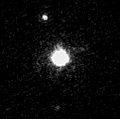Moons of Haumea facts for kids
Haumea is a special dwarf planet far out in space. It has two natural satellites, which we call moons. Their names are Hi'iaka and Namaka. These moons are named after the daughters of Haumea, who is a Hawaiian goddess of fertility and childbirth. Hi'iaka was known as the goddess of dance, and Namaka was the goddess of water and the sea.
Scientists found these two moons in 2005. They used powerful telescopes at the W. M. Keck Observatory in Hawaii to spot them.
Contents
Meet Hi'iaka and Namaka
Hi'iaka is the larger of Haumea's two moons. It is about 350 kilometers (217 miles) wide. This makes it the outermost moon, orbiting further away from Haumea. Hi'iaka has a lot of ice covering its surface.
Namaka is much smaller than Hi'iaka. It is only about one-tenth the size of its big sister moon. Namaka's path around Haumea is a bit unusual. Its orbit is affected by the stronger pull of the larger moon, Hi'iaka.
How Haumea's Moons Formed
Scientists believe that Haumea's moons were created billions of years ago. This happened after something big crashed into Haumea. The crash broke off a large chunk of Haumea's icy outer layer. This broken-off ice then came together to form Hi'iaka and Namaka.
Discovery and Naming of the Moons
Hi'iaka was the first moon to be discovered. This happened on January 26, 2005. At first, scientists gave it the fun nickname "Rudolph the Red Nosed Reindeer."
Namaka was found a few months later, on June 30, 2005. It was nicknamed "Blitzen the Reindeer."
The International Astronomical Union (IAU) is the group that officially names objects in space. They gave Hi'iaka and Namaka their official names on September 17, 2008.
Images for kids
-
Animation of Haumea and its moons, imaged by Hubble in 2008. Hiʻiaka is the brighter object around Haumea (center), and Namaka is the dimmer object below.
-
Keck telescope image of Haumea (center), Hiʻiaka (above), and Namaka (below).





